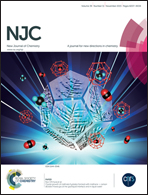PEGylated Gd(OH)3 nanorods as metabolizable contrast agents for computed tomography imaging†
Abstract
Along with the rapid development of modern medicine, the creation and evaluation of nanoparticulate contrast agents have attracted considerable attention of scientists worldwide. Herein, we designed and synthesized a metabolizable nano-sized contrast agent based on rod-like PEGylated gadolinium hydroxide (defined as PEG-Gd(OH)3) via a facile and economic route. Due to the high amount of gadolinium in these nanorods, these well-prepared PEG-Gd(OH)3 could provide more enhanced contrast than clinical iodine-based agents under the usual voltages in computed tomography (CT) imaging. Different from other small molecule-based contrast agents, our PEG-Gd(OH)3 exhibited an obvious liver-targeted property based on our in vivo experiments, indicating their expected usage in the detection of hepatic metastases. Long-term toxicity and possible metabolic pathway demonstrated that these nanorods exhibit overall safety and could not cause gadolinium-associated nephrogenic systemic fibrosis (NSF). With its high biocompatibility and superior contrast efficacy, PEG-Gd(OH)3 could bring more opportunities to a new generation of nanoparticulate CT contrast agents in biomedicine.


 Please wait while we load your content...
Please wait while we load your content...